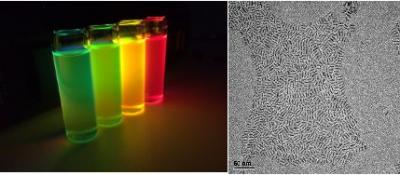Dr. Lioz Etgar obtained his Ph.D. at the Technion'Israel Institute of Technology, and completed his post-doctoral research with Prof. Michael Grätzel at EPFL, Switzerland. Dr. Etgar was the first to demonstrate the possibility to work with the perovskite as light harvester and hole conductor in the solar cell which result in one of the pioneer publication in this field.

Dr. Etgar is now leading the Perovskite solar lab in the Hebrew University in Jerusalem, Israel. Etgar's research group focuses on the development of innovative solar cells. Etgar is searching for new excitonic solar cells architectures while designing and controlling the inorganic light harvester structure and properties to improve the photovoltaic parameters. Etgar was kind enough to answer a few questions we had for him.
Q: First of all, can you describe the current perovskite research approach at HUJI?
My research group at HUJI concentrates on two main areas related to the perovskite field. First is a unique solar cell structure eliminating the hole transport material layer. We found that the perovskite can function simultaneously as hole transport material and light harvester.
This is a very unique property for a semiconductor actually in the PV field there is not such a semiconductor which has this property. The elimination of Hole conductor layer has several advantageous such as reducing the cost, simplifying the fabrication process and open up the possibly to simple tandem cell fabrication.
The second main area is related to nanostructures made of organo-metal perovskite. This is a growing niche in the perovskite research field which open the possibility to LEDs and lasing applications. The HUJI team first reported on organo metal nano rods (NRs) made at room temperature with narrow size distribution and tunable optical properties. Moreover, recent developments are demonstrating the control over the number of the layered perovskite (so called two dimensional perovskite) and their effective implementation in the solar cell gaining high voltage solar cells which is additional benefit of the perovskite.

My research group have published over 30 papers in the last 4 years related to perovskite.
Q: You were part of the original team at EPFL that studied perovskite PVs. Can you share that experience with us?
I was among the first who worked on the perovskite since its breakthrough. During my last month as a postdoc at EPFL I found that the perovskite can be function as light harvester and hole conductor at the same time. This work was published in JACS already on September 2012, which is one of the first publication related to the use of perovskite in the solar cell.
The idea of working without a hole conductor came to me from the solid state QDs solar cells. I worked on it several years during my stay at EPFL (as this was and still is my main specialty). Therefore, it was obvious for me to apply this idea to the perovskite cells which amazingly worked very good.
Q: Many people speak of toxicity and stability as two major problems with perovskites,. What do you think are the main challenges for perovskite solar technologies going forward?
I agree that stability is one of the important factors for the technology to move forward. Already today there is a big progress in term of stability, on one hand the device structures are more stable including encapsulation and additional layers which prevent from humidity to interact with the perovskite.
On the other hand, there is also a progress in the perovskite itself, using smart chemistry which makes the material more resistive to humidity. Therefore, it seems that the stability is a matter of time and it will not be the main factor to prevent from this technology to progress.
For the toxicity, replacing the lead is a challenging topic, at this stage we can't recognize a good replacement which will even get close to the performance of perovskite based Lead. The only nice direction is half replacement of the lead by tin (Sn).
For the long term, replacing the lead will be an interesting topic which is mainly related to research in the academia, however it will not prevent from the technology to progress further. Moreover, several calculations have been made which show the small amount of lead per perovskite solar cell.
Q: When do you believe we will start seeing perovskite solar panels available commercially? What will be their main advantages over silicon?
The perovskite field is still developing very quickly; I think that this is an opportunity for us to study a material which has never been investigated in details in particular for solar cells. Indeed, the efficiency of a perovskite solar cell today is close to silicon solar cell, however the silicon industry and technology are well established, therefore it will take time to develop such technology which is just based on perovskite.

The advantageous of the perovskite is the possibility to integrate it with the silicon cells to a tandem structure achieving higher efficiencies than each cell separately. Second, the possibility to make it transparent and efficient open the possibility to the building integrated photovoltaic (BIPV) while the third advantageous is related to the fabrication process of the perovskite which don't require high temperature which opens us the possibility to make flexible solar cells with high efficiency.
The second and the third points could be done by dye sensitized solar cells and organic photovoltaic, however their efficiency is much lower than the perovskite solar cells.
Finally I assume that in several years you will see solar cells based on perovskite in the market.
Thanks for your time and answers, Lioz, good luck to you and your research team!



